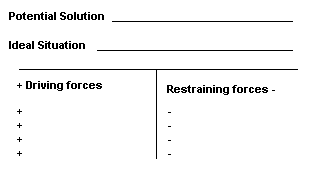 |
Issue
49: September 12, 2005
To our readers:
Business, like life, is either full of problems or full of opportunities for solving problems. To make sure your business or organization operates as though "there are no problems, just opportunities," you need only foster a culture in which employees grasp the opportunity to solve problems whenever they occur. Successful businesses such as General Electric, Xerox and Home Depot have done this.
The previous two issues of Brief Tips focused on creating employee involvement teams and identifying root causes of problems. This issue will complete the series by providing tips for identifying the best solution and for determining first steps in an action plan.
Once team members have identified the likely, actionable Root Cause(s) of a problem, they should employ brainstorming again (see last month's Brief Tips) to generate alternative solutions (countermeasures) for each one. The focus of this step is to generate, not evaluate. Remember: the more alternatives you generate, the better.
Once the team has listed all potential countermeasures, team members can evaluate the merit of those countermeasures based on Effectiveness (E) and Feasibility (F).
Each idea on the list of alternatives should be judged on its feasibility and effectiveness by each team member. Keep in mind that in many instances feasibility is more important than effectiveness. If a potential alternative is cost prohibitive (has zero feasibility), its effectiveness has little meaning.
|
 |
Use a five-point scale, with five indicating most feasible or most effective. Multiply the effectiveness and feasibility numbers for an overall score. Once all team members have rated the ideas, total the responses. The highest-scoring alternative should be the best choice.

Another helpful tool in evaluating countermeasures is Force Field Analysis, a technique developed by Kurt Lewin that involves identifying the forces and factors in place that support (positive driving forces) or work against (negative restraining forces) the potential solution. Once identified, the positive forces can be reinforced and the negative ones eliminated or reduced.
Draw the letter "T" on a piece of paper. At the top of the "T" write the potential solution the team is evaluating. Also write the ideal situation your team would like to achieve. Brainstorm the forces that are driving you toward the ideal situation and write them on the left side of the "T". Brainstorm the forces that are keeping you from achieving the ideal solution and write them on the right side of the "T".
 Assign a priority weight to each item, remembering that it is often more helpful and feasible to remove barriers than to implement driving forces.
Assign a priority weight to each item, remembering that it is often more helpful and feasible to remove barriers than to implement driving forces.
Looking at Cost effectiveness is also a method of evaluating potential solutions. How long will it take to recover the investment necessary to implement the proposed solution? What is the cost of doing nothing? Is cost a driving force or a restraining force?
|
 |
Once the team has evaluated all countermeasures and reached consensus on the best solution, the team can create First Step Action Plans.
To draw up an Action Plan, simply list the tasks you need to carry out to achieve your goal. Sounds simple, but is nonetheless very useful! It differs from a "To Do List" in that it focuses on the achievement of a single goal. For each task answer the following questions:
Who will be responsible for completing the task?
What resources will be required to complete the task?
When will the task be completed? List all milestones and a projected completion date.
Wherever you want to achieve something, draw up an action plan. This allows you to concentrate on the stages of that achievement, and monitor your progress towards it. It requires team members to be personally responsible for specific tasks, and to complete them by an agreed-upon date.
For additional resources for problem-solving and continuous improvement, visit GOAL/QPC . They publish The Memory Jogger - A Pocket Guide of Tools for Continuous Improvement and Effective Planning.
With the right preparation, solving problems is like playing a game, one your employees will enjoy playing and will know they can win.
|
 |